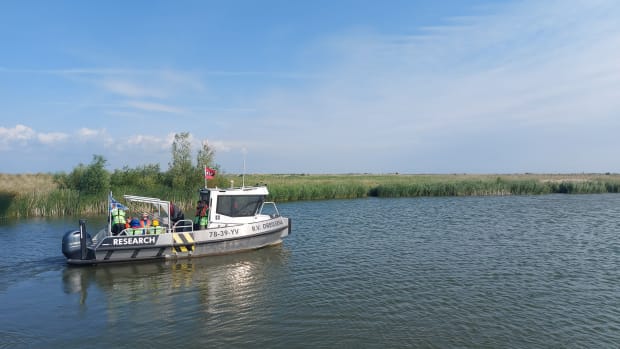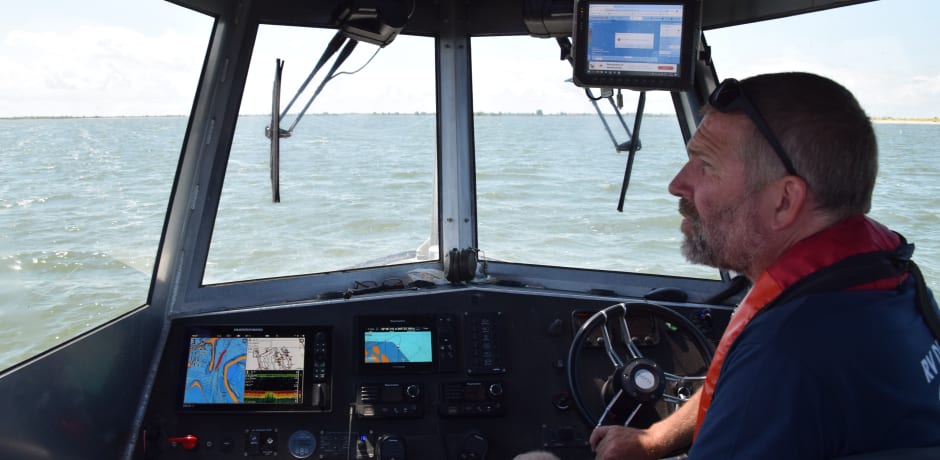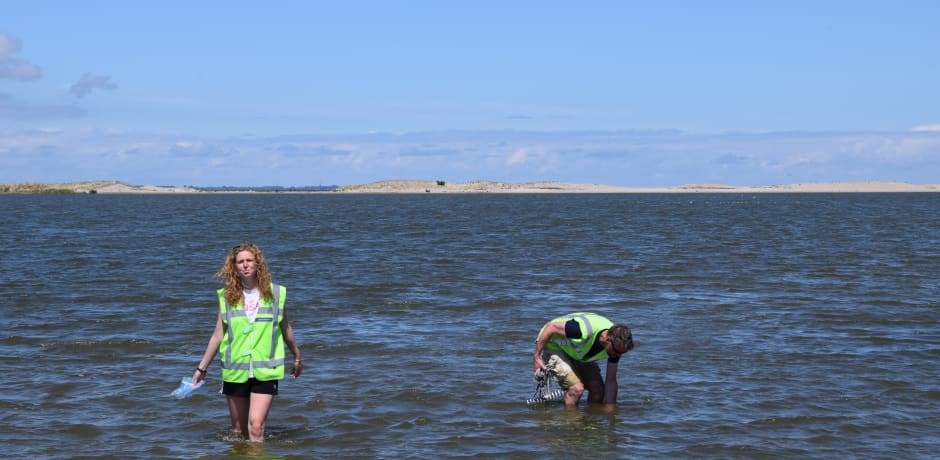
Is the Markermeer benefiting from the Marker Wadden? “For nature’s sake, it would be better to breach the Afsluit dike”
Since the advent of the Afsluit dike, the Markermeer has been in bad shape. So 10 years ago the Marker Wadden islands were raised from silt to save nature. For the second year, UvA students are investigating whether that has succeeded already.
At first glance, it looks like summer vacation has already begun. On a beach at the Marker Wadden, a dozen students in bikinis hang out in beach chairs, some with laptops on their laps. Inside the field station where they spend the night, sandwiches are being baked.
Yet the fieldwork week for second-year biology students is not just vacation. For example, there are night excursions to look for plankton, the alarm is invariably set for seven in the morning, and the students go out on the water in all kinds of weather. All of this is to find out if the tiny islands, the Marker Wadden, will provide the promised nature restoration in the Markermeer.
Excavated from silt
The ecological quality of the Markermeer drastically deteriorated with the arrival of the Afsluit dike and the Houtrib dike, which separate the Markermeer from the IJsselmeer, say aquatic biologists Harm van der Geest and Arie Vonk. They have been researching the lake for years and are supervising the students. On the site of the Zuider Lake, dikes created the Markermeer: a “dead, stagnant basin of water” with a thick layer of silt.
The Marker Wadden are an example of a new kind of nature. Instead of classical nature conservation, which traditionally aims to preserve nature or return it to the way it was, the Marker Wadden constitute an experiment to create a new nature area, called forward restoration. After all, the Zuider Lake that was once there will not return. It is therefore impossible to predict what the area will look like in 10 or 100 years, but it is interesting to examine as a case study for other forward restoration projects.
“That description is not entirely accurate,” Van der Geest clarifies. “All kinds of plants and fish live in the Markermeer. It is a Natura-2000 area and the blue heart of the Netherlands for a reason.” Still, it was a good starting point to justify the Marker Wadden project, for which €80 million were allocated. Fertile silt, sand, and clay from the bottom of the Markermeer was brought up to form five islands, nine kilometers sailing distance from Lelystad. Clear creeks were to be created between the islands where reeds and aquatic plants could grow and fish could spawn. The nature restoration on the Marker Wadden would benefit the water quality of the entire lake, was the reasoning of the project designers, Natuurmonumenten and Rijkswaterstaat.
Starting in 2016, the islands began emerging. There are now seven of them and they are abundantly overgrown with spontaneously emerging plant species such as marsh endive, the first willow trees, planted reeds, marram grass, and birdsfoot trefoil, which grows along the walkways. The islands have also become a popular breeding ground for bird species and a nursery for fish. But to what extent do these islands also provide nature restoration in the rest of Markermeer? That is what the UvA students are researching.
Green water plants
Second-year biology students Elisa Westerman (20), Floris Timmer (23), and Ties de Kousemaeker (20) are investigating what plant species grow on the bottom around the Marker Wadden. And does the turbidity of the water play a role in this? Vonk and Van der Geest take the trio on their research boat the R.V. Dreissena to the shallow creeks between two islands, where tourists are not allowed, while paying attention to exactly where the boat can navigate because the shifting sand means the depth charts are not very accurate.
(Text continues below the image.)

“Huge plants, right here behind the boat,” Van der Geest sees on the sonar images measuring the depth under the boat. He parks the boat near a sandbar and the students enter the water. Using rakes and their hands, they remove several green aquatic plants from the bottom. “We didn’t have these yet,” the students conclude with satisfaction. Back on the deck, they rinse the plants in a sieve. Then they go into numbered plastic bags for further analysis in the lab. The students cannot yet draw any conclusions. “Back in Amsterdam, we will really get to work on the data analysis.”
(Text continues below the image.)

Ultimately, these small investigations can paint a picture of the best conditions for food production on an artificial island. For example, another group of students is investigating which “little critters,” such as water fleas, worms, and insect larvae, grow near which plant species and at what depth. This way the students’ research can identify hotspots for food production on the island, knowledge that can eventually be used to restore nature in other man-made lakes.
Natural shores
Food production must eventually end up in the lake to increase its ecological quality. After all, that is where small organisms such as bacteria and insect larvae can live, which in turn are food for birds and fish. Because of the steep, stone dikes that largely surround the Markermeer, that supply has almost completely disappeared, as Vonk and Van der Geest described in an article published in mid-May.
Vonk says: “Currently, it is mainly plankton and algae that produce organic material for the fish and birds in the Markermeer. In a ‘natural’ situation, that organic material is replenished from the lakeshore when aquatic plants die and end up in the lake. In a healthy lake, up to 50 percent of the lake’s food supply comes from the shoreline.”
Also, organic material from the new islands has not yet been found in the Markermeer. Van der Geest says: “One explanation could be that the Marker Wadden are still very young, and even at 700 hectares, too small to provide food for the entire Markermeer.”
Holes in the Afsluit dike
Another explanation is that food production on the islands is not reaching the Markermeer. That is because the water level of the Markermeer - also an important freshwater supply for the Netherlands - is regulated. That means that the Marker Wadden are not subjected to any of the varying water levels in dry and wet years. It is precisely these floods that cause organic material and nutrients to leach into the lake.
To get that exchange going nonetheless, there are holes in the dunes of the Marker Wadden allowing water to flow into the area with a strong southerly wind, temporarily raising the water level. But is that enough?
To get that exchange going nonetheless, there are holes in the dunes of the Marker Wadden allowing water to flow into the area with a strong southerly wind, temporarily raising the water level. But is that enough?
The researchers propose increasing the flow of energy from the riparian areas. This can be done by creating more islands, or by expanding the natural shores on the western side of the lake. A nature reserve like the Oostvaardersplassen would ideally also overflow into the lake, but that is now closed off from it with a large dike and has a difference in water level of four meters.
“I myself would be in favor of making holes in the Afsluit dike and replacing the Houtrib dyke with a large group of islands like the Marker Wadden, to bring back the dynamics in the area,” Van der Geest suggests. “But you also need those dikes as flood protection for Amsterdam. So that’s really a bridge too far because of water safety and is never going to happen. Maybe 50 years from now.”

